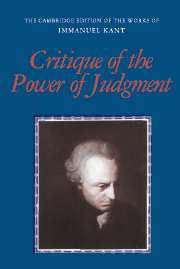Book contents
- Frontmatter
- Contents
- General editors' preface
- Editor's introduction
- First Introduction to the Critique of the Power of Judgment
- Critique of the Power of Judgment
- Preface
- Introduction
- First Part: Critique of the Aesthetic Power of Judgment
- First Section, First Book: Analytic of the Beautiful
- First Section, Second Book: Analytic of the Sublime
- Deduction of Pure Aesthetic Judgments
- Second Section: The Dialectic of the Aesthetic Power of Judgment
- Appendix: On the Methodology of Taste
- Second Part: Critique of the Teleological Power of Judgment
- Appendix: Methodology of the Teleological Power of Judgment
- Method of citation and abbreviations
- Editorial notes
- Glossary
- Index
Second Section: The Dialectic of the Aesthetic Power of Judgment
Published online by Cambridge University Press: 05 April 2013
- Frontmatter
- Contents
- General editors' preface
- Editor's introduction
- First Introduction to the Critique of the Power of Judgment
- Critique of the Power of Judgment
- Preface
- Introduction
- First Part: Critique of the Aesthetic Power of Judgment
- First Section, First Book: Analytic of the Beautiful
- First Section, Second Book: Analytic of the Sublime
- Deduction of Pure Aesthetic Judgments
- Second Section: The Dialectic of the Aesthetic Power of Judgment
- Appendix: On the Methodology of Taste
- Second Part: Critique of the Teleological Power of Judgment
- Appendix: Methodology of the Teleological Power of Judgment
- Method of citation and abbreviations
- Editorial notes
- Glossary
- Index
Summary
A power of judgment that is to be dialectical must first of all be rationalistic, i.e., its judgments must lay claim to universality, and indeed do so a priori, for the dialectic consists in the opposition of such judgments. Hence the incompatibility of aesthetic judgments of sense (about the agreeable and the disagreeable) is not dialectical. Even the conflict between judgments of taste, insofar as each person appeals merely to his own taste, does not constitute a dialectic of taste, since no one has any thought of making his own judgment into a universal rule. Thus there remains no other concept of a dialectic that could apply to taste except that of a dialectic of the critique of taste (not of taste itself) with regard to its principles: namely, where mutually conflicting concepts of the basis of the possibility of judgments of taste naturally and unavoidably emerge. A transcendental critique of taste will thus contain a part that can bear the name of a dialectic of the aesthetic power of judgment only if there is an antinomy of the principles of this faculty, which makes its lawfulness and hence also its inner possibility doubtful.
Representation of the antinomy of taste.
The first commonplace of taste is contained in the proposition by means of which everyone who lacks taste thinks to defend himself against criticism: Everyone has his own taste. That amounts to saying that the determining ground of this judgment is merely subjective (gratification or pain), and the judgment has no right to the necessary assent of others.
- Type
- Chapter
- Information
- Critique of the Power of Judgment , pp. 213 - 228Publisher: Cambridge University PressPrint publication year: 2000



